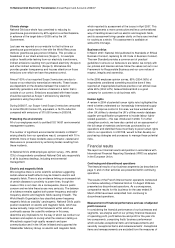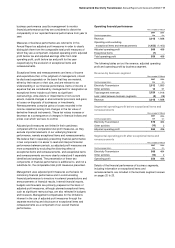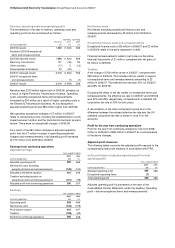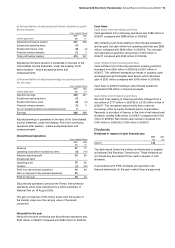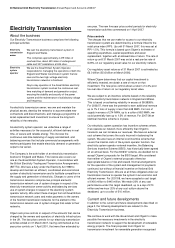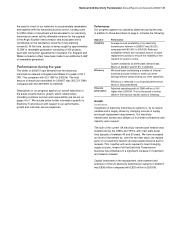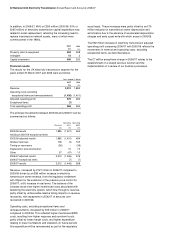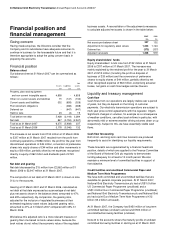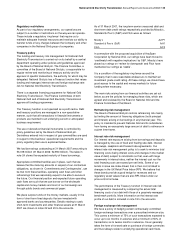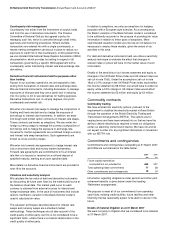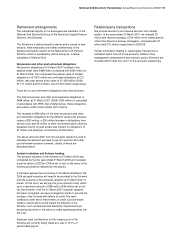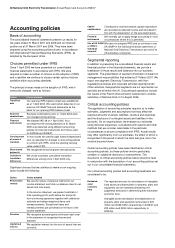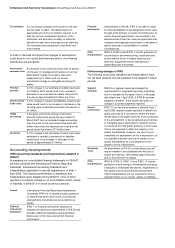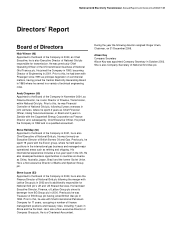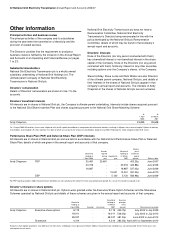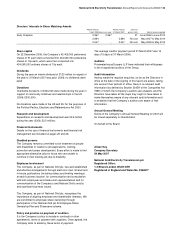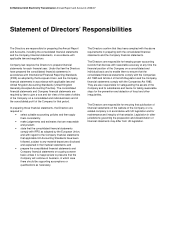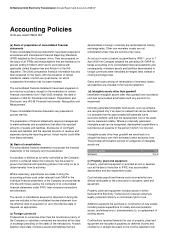National Grid 2007 Annual Report Download - page 28
Download and view the complete annual report
Please find page 28 of the 2007 National Grid annual report below. You can navigate through the pages in the report by either clicking on the pages listed below, or by using the keyword search tool below to find specific information within the annual report.
26 National Grid Electricity Transmission Annual Report and Accounts 2006/07
Counterparty risk management
Counterparty risk arises from the investment of surplus funds
and from the use of derivative instruments. The Finance
Committee of National Grid plc has agreed a policy for
managing such risk, which is controlled through credit limits,
approvals and monitoring procedures. Where multiple
transactions are entered into with a single counterparty, a
master netting arrangement can be put in place to reduce our
exposure to credit risk of that counterparty. At the present time,
we use standard International Swap Dealers Association (ISDA)
documentation, which provides for netting in respect of all
transactions governed by a specific ISDA agreement with a
counterparty, when transacting interest rate and exchange rate
derivatives.
Derivative financial instruments held for purposes other
than trading
As part of our business operations, we are exposed to risks
arising from fluctuations in interest rates and exchange rates.
We use financial instruments, including derivatives, to manage
exposures of this type and they are a useful tool in reducing
risk. Our policy is not to use derivatives for trading purposes.
Derivative transactions can, to varying degrees, carry both
counterparty and market risk.
We enter into interest rate swaps to manage the composition of
floating and fixed rate debt and so hedge the exposure of
borrowings to interest rate movements. In addition, we enter
into bought and written option contracts on interest rate swaps.
These contracts are known as swaptions. We also enter into
foreign currency swaps to manage the currency composition of
borrowings and so hedge the exposure to exchange rate
movements. Certain agreements are combined foreign currency
and interest rate swap transactions. Such agreements are
known as cross-currency swaps.
We enter into forward rate agreements to hedge interest rate
risk on short-term debt and money market investments.
Forward rate agreements are commitments to fix an interest
rate that is to be paid or received on a notional deposit of
specified maturity, starting at a future specified date.
More details on derivative financial instruments are provided in
note 18 to the accounts.
Valuation and sensitivity analysis
We calculate the fair value of debt and derivative instruments
by discounting all future cash flows by the market yield curve at
the balance sheet date. The market yield curve for each
currency is obtained from external sources for interest and
foreign exchange rates. In the case of instruments that include
options, the Black’s variation of the Black-Scholes model is
used to calculate fair value.
The valuation techniques described above for interest rate
swaps and currency swaps are a standard market
methodology. These techniques do not take account of the
credit quality of either party, but this is not considered to be a
significant factor, unless there is a material deterioration in the
credit quality of either party.
In relation to swaptions, we only use swaptions for hedging
purposes with a European style exercise. As a consequence,
the Black’s variation of the Black-Scholes model is considered
to be sufficiently accurate for the purpose of providing fair value
information in relation to these types of swaptions. More
sophisticated valuation models exist but we do not believe it is
necessary to employ these models, given the extent of our
activities in this area.
For debt and derivative instruments held, we utilise a sensitivity
analysis technique to evaluate the effect that changes in
relevant rates or prices will have on the market value of such
instruments.
Details of the sensitivity of our income statement and equity to
changes in the UK Retail Prices Index and UK interest rates are
set out in note 19(d). Under the assumptions set out in note
19(d) a 0.5% change in the UK Retail Prices Index would affect
the income statement by £8 million, but would have no effect on
equity, while a 0.5% change in UK interest rates would affect
the income statement by £2 million and equity by £3 million.
Commodity contracts
Commodity trading
We have entered into electricity options, pursuant to the
requirement to stabilise the electricity market in Great Britain
through the operation of the British Electricity Trading and
Transmission Arrangements (BETTA). The options are for
varying terms and have been entered into so that we have the
ability to deliver electricity as required to meet our obligations
under our electricity transmission licence. We have not and do
not expect to enter into any significant derivatives in connection
with our BETTA role.
Commitments and contingencies
Commitments and contingencies outstanding at 31 March 2007
and 2006 are summarised in the table below:
2007
2006
£m
£m
Future capital expenditure
contracted but not provided for 665
337
Total operating lease commitments 77
28
Other commitments and contingencies 19
19
Information regarding obligations under pension and other post-
retirement benefits is given below under the heading
‘Retirement arrangements’.
We propose to meet all of our commitments from operating
cash flows, existing credit facilities, future facilities and other
financing that we reasonably expect to be able to secure in the
future.
Details of material litigation as at 31 March 2007
We were not party to litigation that we considered to be material
at 31 March 2007.


